Creativity and Innovation in Business: Google Case Study Report
VerifiedAdded on 2021/04/17
|9
|1793
|119
Report
AI Summary
This report provides a comprehensive analysis of Google's creativity and innovation in business. It begins with an introduction and background of the company, including its size, history, and structure. The report then delves into Google's current business model, products, services, and target markets. An entrepreneurial assessment is conducted, analyzing the company's vision, corporate strategy, and the top management team's entrepreneurial mindset. The report proposes strategies for entrepreneurship and innovation, focusing on Google's culture and key values. Recommendations are offered, including suggestions for workforce development, and the report concludes with a summary of key findings and references.
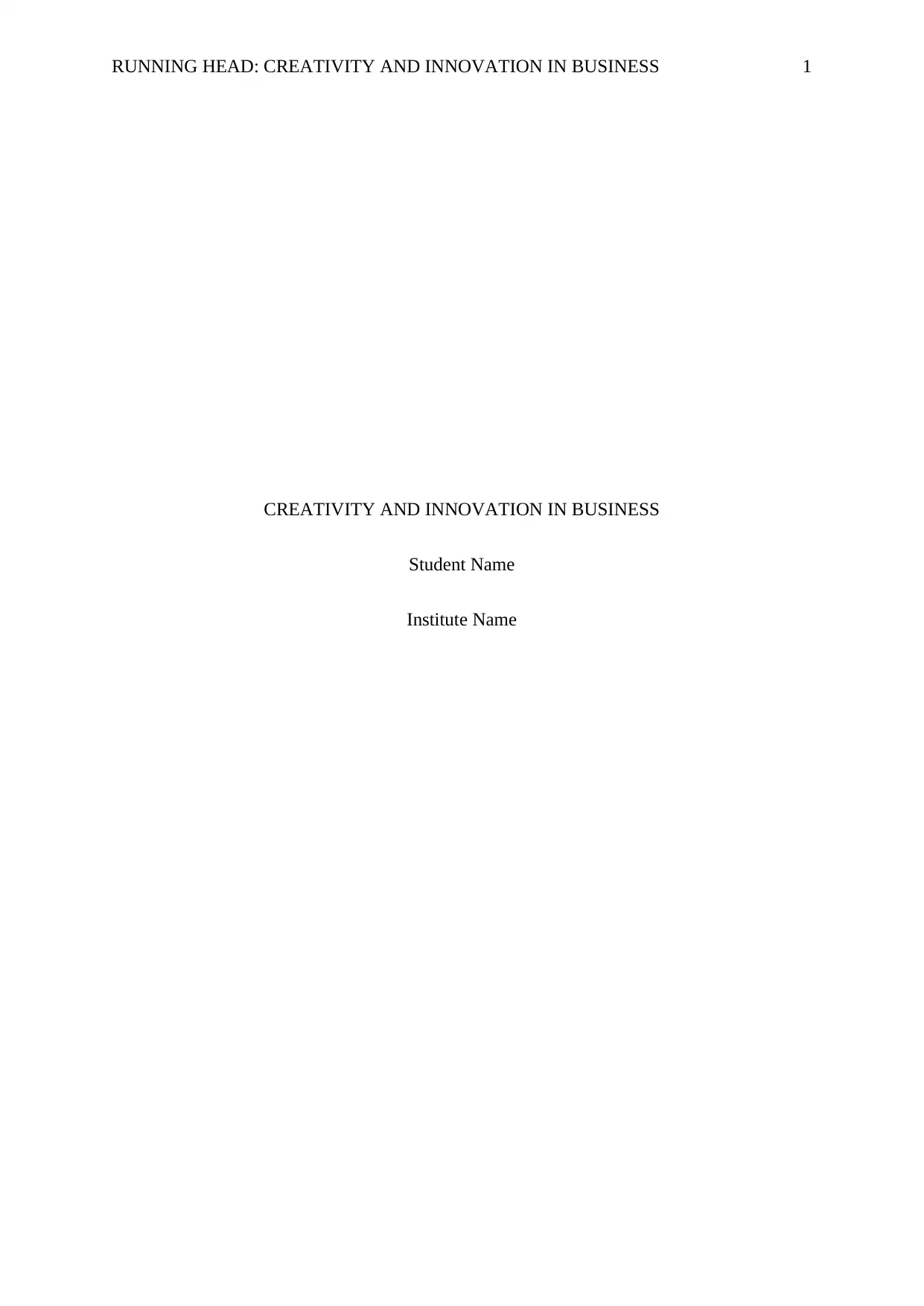
RUNNING HEAD: CREATIVITY AND INNOVATION IN BUSINESS 1
CREATIVITY AND INNOVATION IN BUSINESS
Student Name
Institute Name
CREATIVITY AND INNOVATION IN BUSINESS
Student Name
Institute Name
Paraphrase This Document
Need a fresh take? Get an instant paraphrase of this document with our AI Paraphraser
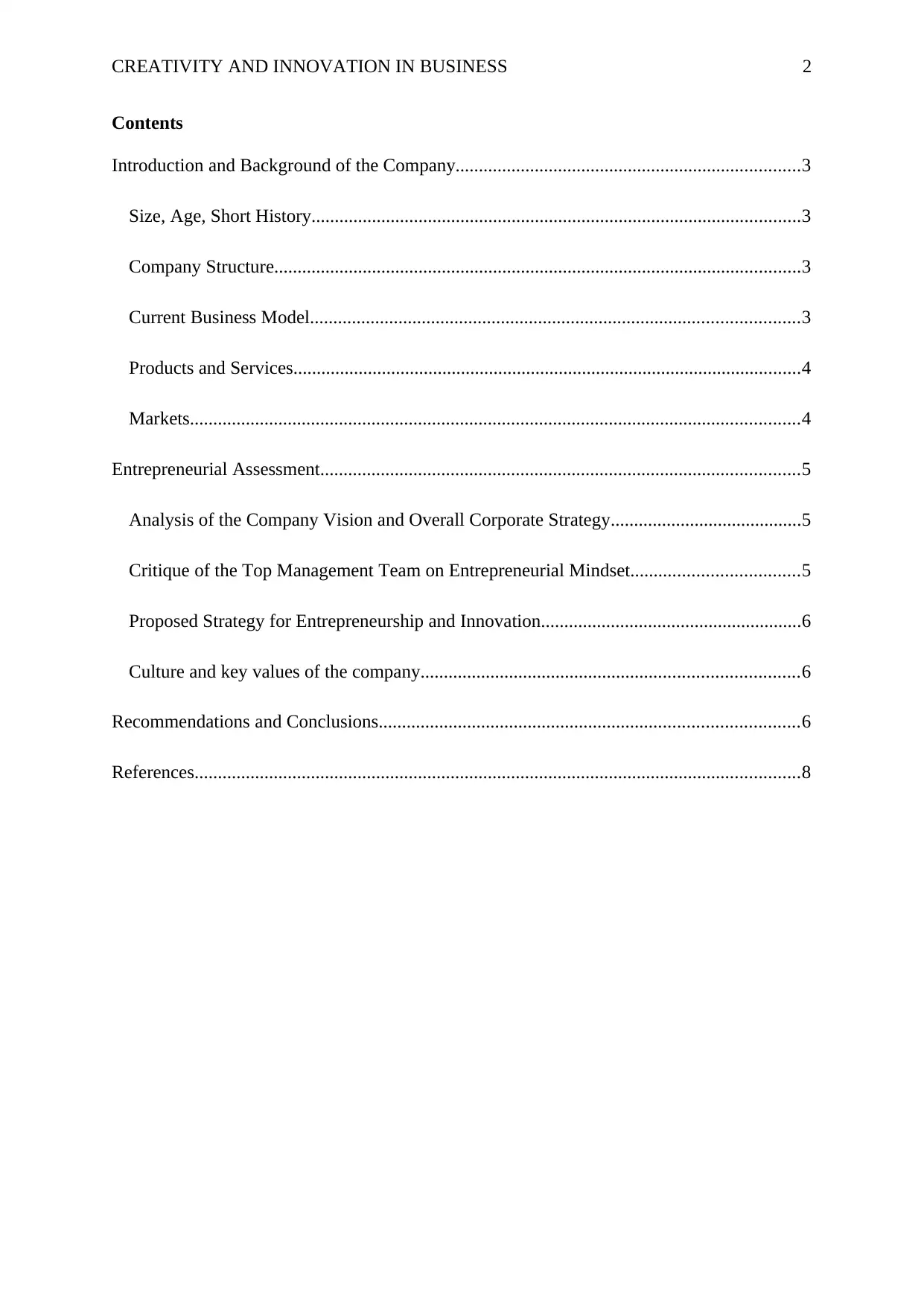
CREATIVITY AND INNOVATION IN BUSINESS 2
Contents
Introduction and Background of the Company..........................................................................3
Size, Age, Short History.........................................................................................................3
Company Structure.................................................................................................................3
Current Business Model.........................................................................................................3
Products and Services.............................................................................................................4
Markets...................................................................................................................................4
Entrepreneurial Assessment.......................................................................................................5
Analysis of the Company Vision and Overall Corporate Strategy.........................................5
Critique of the Top Management Team on Entrepreneurial Mindset....................................5
Proposed Strategy for Entrepreneurship and Innovation........................................................6
Culture and key values of the company.................................................................................6
Recommendations and Conclusions..........................................................................................6
References..................................................................................................................................8
Contents
Introduction and Background of the Company..........................................................................3
Size, Age, Short History.........................................................................................................3
Company Structure.................................................................................................................3
Current Business Model.........................................................................................................3
Products and Services.............................................................................................................4
Markets...................................................................................................................................4
Entrepreneurial Assessment.......................................................................................................5
Analysis of the Company Vision and Overall Corporate Strategy.........................................5
Critique of the Top Management Team on Entrepreneurial Mindset....................................5
Proposed Strategy for Entrepreneurship and Innovation........................................................6
Culture and key values of the company.................................................................................6
Recommendations and Conclusions..........................................................................................6
References..................................................................................................................................8
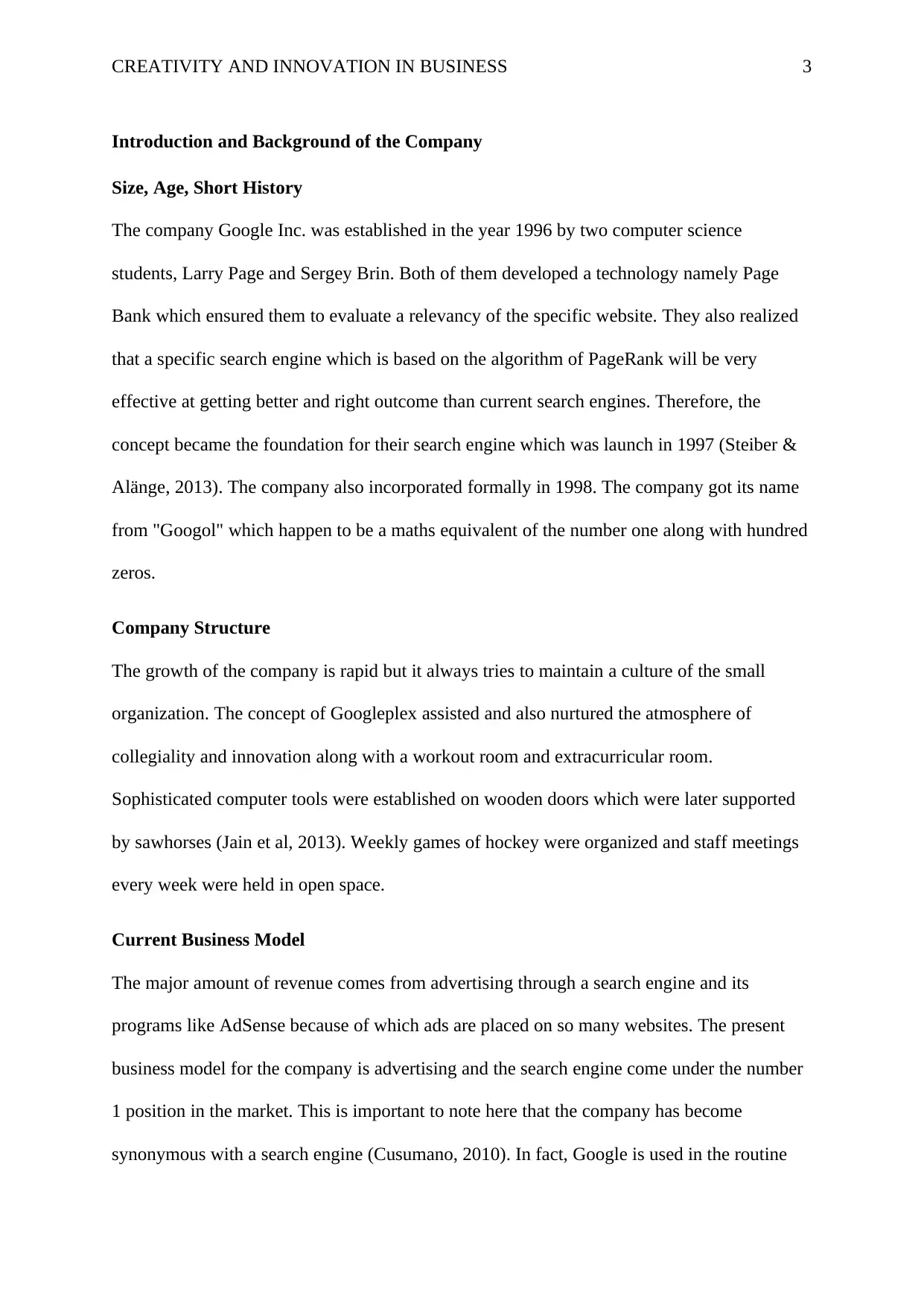
CREATIVITY AND INNOVATION IN BUSINESS 3
Introduction and Background of the Company
Size, Age, Short History
The company Google Inc. was established in the year 1996 by two computer science
students, Larry Page and Sergey Brin. Both of them developed a technology namely Page
Bank which ensured them to evaluate a relevancy of the specific website. They also realized
that a specific search engine which is based on the algorithm of PageRank will be very
effective at getting better and right outcome than current search engines. Therefore, the
concept became the foundation for their search engine which was launch in 1997 (Steiber &
Alänge, 2013). The company also incorporated formally in 1998. The company got its name
from "Googol" which happen to be a maths equivalent of the number one along with hundred
zeros.
Company Structure
The growth of the company is rapid but it always tries to maintain a culture of the small
organization. The concept of Googleplex assisted and also nurtured the atmosphere of
collegiality and innovation along with a workout room and extracurricular room.
Sophisticated computer tools were established on wooden doors which were later supported
by sawhorses (Jain et al, 2013). Weekly games of hockey were organized and staff meetings
every week were held in open space.
Current Business Model
The major amount of revenue comes from advertising through a search engine and its
programs like AdSense because of which ads are placed on so many websites. The present
business model for the company is advertising and the search engine come under the number
1 position in the market. This is important to note here that the company has become
synonymous with a search engine (Cusumano, 2010). In fact, Google is used in the routine
Introduction and Background of the Company
Size, Age, Short History
The company Google Inc. was established in the year 1996 by two computer science
students, Larry Page and Sergey Brin. Both of them developed a technology namely Page
Bank which ensured them to evaluate a relevancy of the specific website. They also realized
that a specific search engine which is based on the algorithm of PageRank will be very
effective at getting better and right outcome than current search engines. Therefore, the
concept became the foundation for their search engine which was launch in 1997 (Steiber &
Alänge, 2013). The company also incorporated formally in 1998. The company got its name
from "Googol" which happen to be a maths equivalent of the number one along with hundred
zeros.
Company Structure
The growth of the company is rapid but it always tries to maintain a culture of the small
organization. The concept of Googleplex assisted and also nurtured the atmosphere of
collegiality and innovation along with a workout room and extracurricular room.
Sophisticated computer tools were established on wooden doors which were later supported
by sawhorses (Jain et al, 2013). Weekly games of hockey were organized and staff meetings
every week were held in open space.
Current Business Model
The major amount of revenue comes from advertising through a search engine and its
programs like AdSense because of which ads are placed on so many websites. The present
business model for the company is advertising and the search engine come under the number
1 position in the market. This is important to note here that the company has become
synonymous with a search engine (Cusumano, 2010). In fact, Google is used in the routine
⊘ This is a preview!⊘
Do you want full access?
Subscribe today to unlock all pages.

Trusted by 1+ million students worldwide
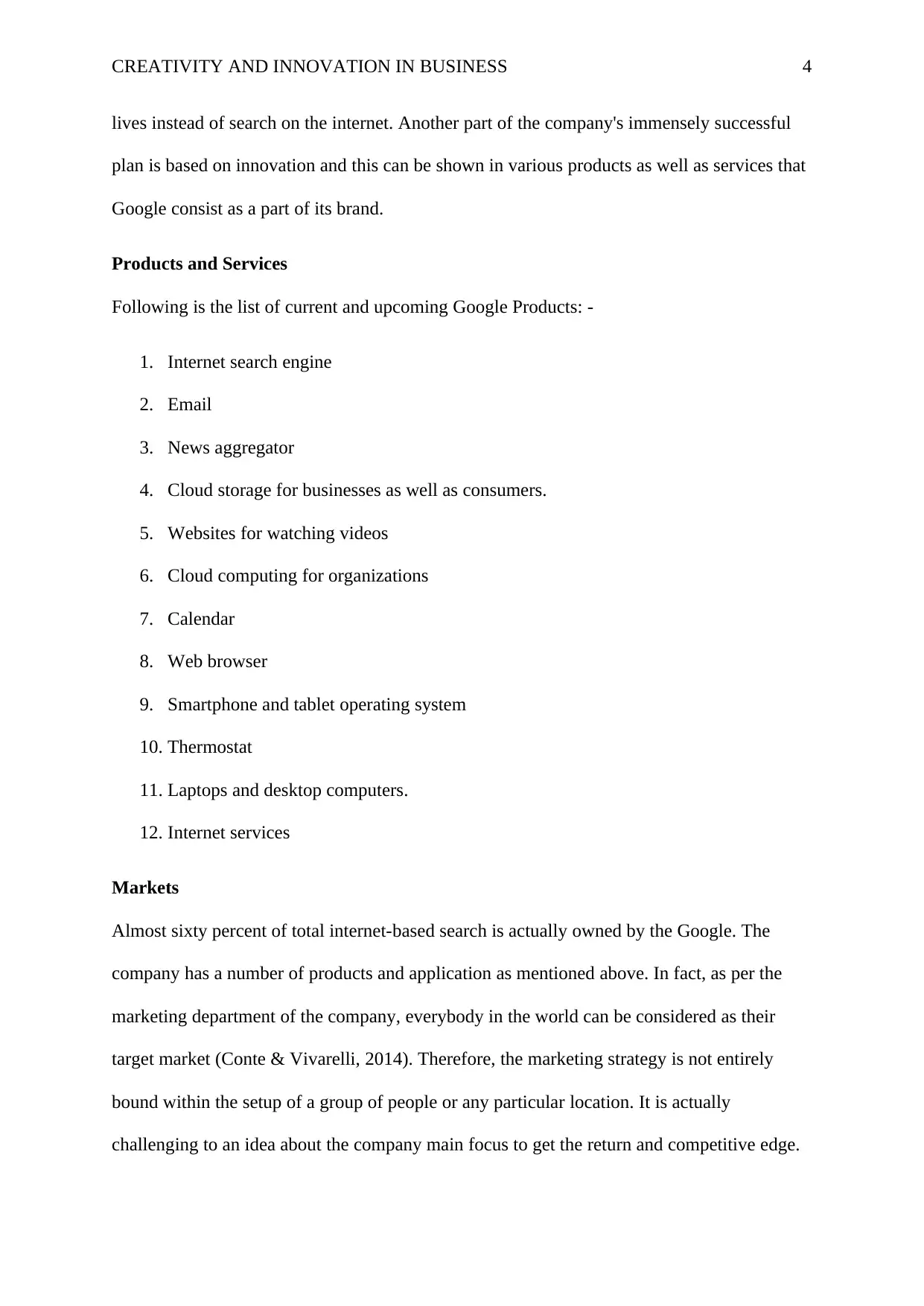
CREATIVITY AND INNOVATION IN BUSINESS 4
lives instead of search on the internet. Another part of the company's immensely successful
plan is based on innovation and this can be shown in various products as well as services that
Google consist as a part of its brand.
Products and Services
Following is the list of current and upcoming Google Products: -
1. Internet search engine
2. Email
3. News aggregator
4. Cloud storage for businesses as well as consumers.
5. Websites for watching videos
6. Cloud computing for organizations
7. Calendar
8. Web browser
9. Smartphone and tablet operating system
10. Thermostat
11. Laptops and desktop computers.
12. Internet services
Markets
Almost sixty percent of total internet-based search is actually owned by the Google. The
company has a number of products and application as mentioned above. In fact, as per the
marketing department of the company, everybody in the world can be considered as their
target market (Conte & Vivarelli, 2014). Therefore, the marketing strategy is not entirely
bound within the setup of a group of people or any particular location. It is actually
challenging to an idea about the company main focus to get the return and competitive edge.
lives instead of search on the internet. Another part of the company's immensely successful
plan is based on innovation and this can be shown in various products as well as services that
Google consist as a part of its brand.
Products and Services
Following is the list of current and upcoming Google Products: -
1. Internet search engine
2. Email
3. News aggregator
4. Cloud storage for businesses as well as consumers.
5. Websites for watching videos
6. Cloud computing for organizations
7. Calendar
8. Web browser
9. Smartphone and tablet operating system
10. Thermostat
11. Laptops and desktop computers.
12. Internet services
Markets
Almost sixty percent of total internet-based search is actually owned by the Google. The
company has a number of products and application as mentioned above. In fact, as per the
marketing department of the company, everybody in the world can be considered as their
target market (Conte & Vivarelli, 2014). Therefore, the marketing strategy is not entirely
bound within the setup of a group of people or any particular location. It is actually
challenging to an idea about the company main focus to get the return and competitive edge.
Paraphrase This Document
Need a fresh take? Get an instant paraphrase of this document with our AI Paraphraser
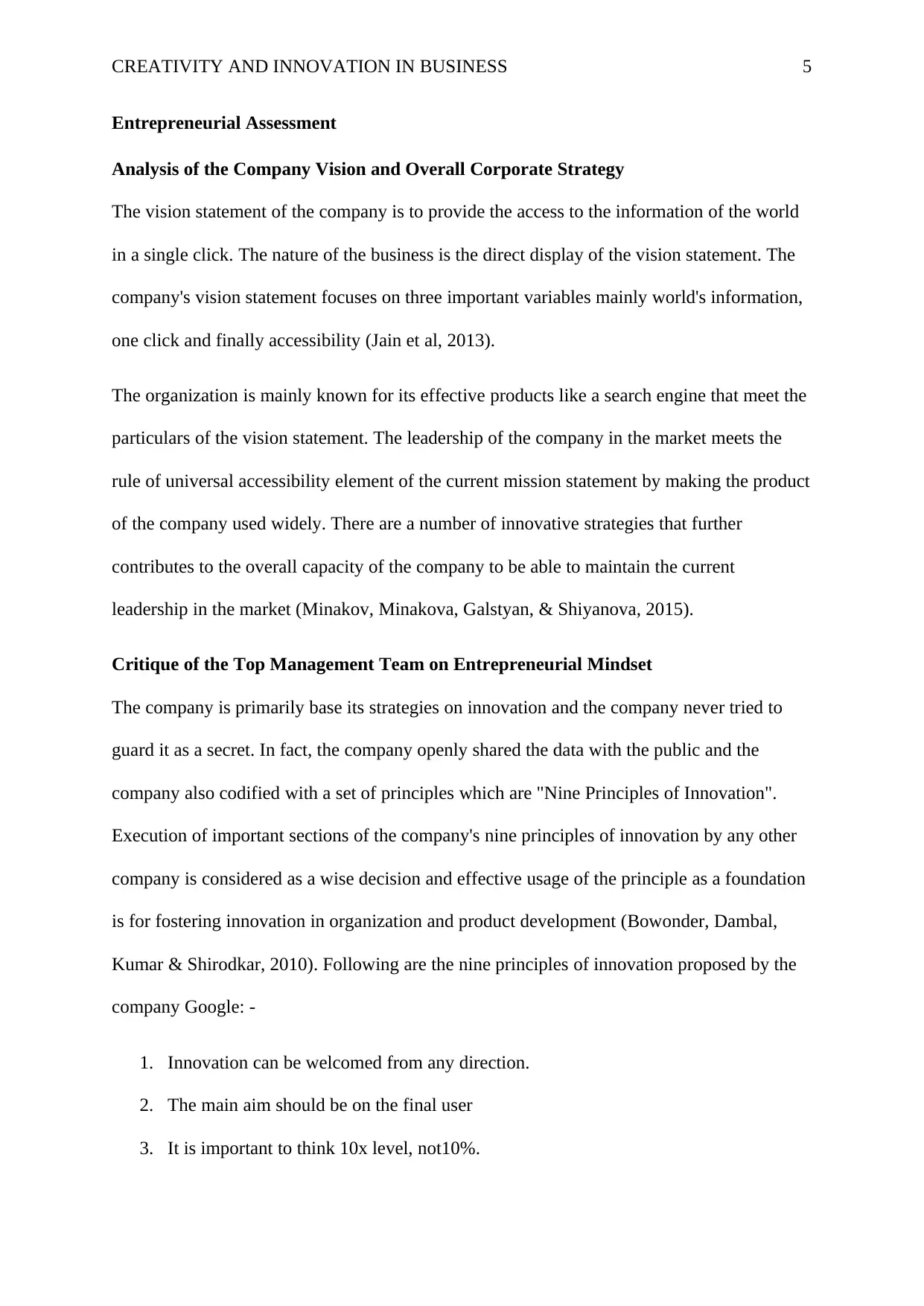
CREATIVITY AND INNOVATION IN BUSINESS 5
Entrepreneurial Assessment
Analysis of the Company Vision and Overall Corporate Strategy
The vision statement of the company is to provide the access to the information of the world
in a single click. The nature of the business is the direct display of the vision statement. The
company's vision statement focuses on three important variables mainly world's information,
one click and finally accessibility (Jain et al, 2013).
The organization is mainly known for its effective products like a search engine that meet the
particulars of the vision statement. The leadership of the company in the market meets the
rule of universal accessibility element of the current mission statement by making the product
of the company used widely. There are a number of innovative strategies that further
contributes to the overall capacity of the company to be able to maintain the current
leadership in the market (Minakov, Minakova, Galstyan, & Shiyanova, 2015).
Critique of the Top Management Team on Entrepreneurial Mindset
The company is primarily base its strategies on innovation and the company never tried to
guard it as a secret. In fact, the company openly shared the data with the public and the
company also codified with a set of principles which are "Nine Principles of Innovation".
Execution of important sections of the company's nine principles of innovation by any other
company is considered as a wise decision and effective usage of the principle as a foundation
is for fostering innovation in organization and product development (Bowonder, Dambal,
Kumar & Shirodkar, 2010). Following are the nine principles of innovation proposed by the
company Google: -
1. Innovation can be welcomed from any direction.
2. The main aim should be on the final user
3. It is important to think 10x level, not10%.
Entrepreneurial Assessment
Analysis of the Company Vision and Overall Corporate Strategy
The vision statement of the company is to provide the access to the information of the world
in a single click. The nature of the business is the direct display of the vision statement. The
company's vision statement focuses on three important variables mainly world's information,
one click and finally accessibility (Jain et al, 2013).
The organization is mainly known for its effective products like a search engine that meet the
particulars of the vision statement. The leadership of the company in the market meets the
rule of universal accessibility element of the current mission statement by making the product
of the company used widely. There are a number of innovative strategies that further
contributes to the overall capacity of the company to be able to maintain the current
leadership in the market (Minakov, Minakova, Galstyan, & Shiyanova, 2015).
Critique of the Top Management Team on Entrepreneurial Mindset
The company is primarily base its strategies on innovation and the company never tried to
guard it as a secret. In fact, the company openly shared the data with the public and the
company also codified with a set of principles which are "Nine Principles of Innovation".
Execution of important sections of the company's nine principles of innovation by any other
company is considered as a wise decision and effective usage of the principle as a foundation
is for fostering innovation in organization and product development (Bowonder, Dambal,
Kumar & Shirodkar, 2010). Following are the nine principles of innovation proposed by the
company Google: -
1. Innovation can be welcomed from any direction.
2. The main aim should be on the final user
3. It is important to think 10x level, not10%.
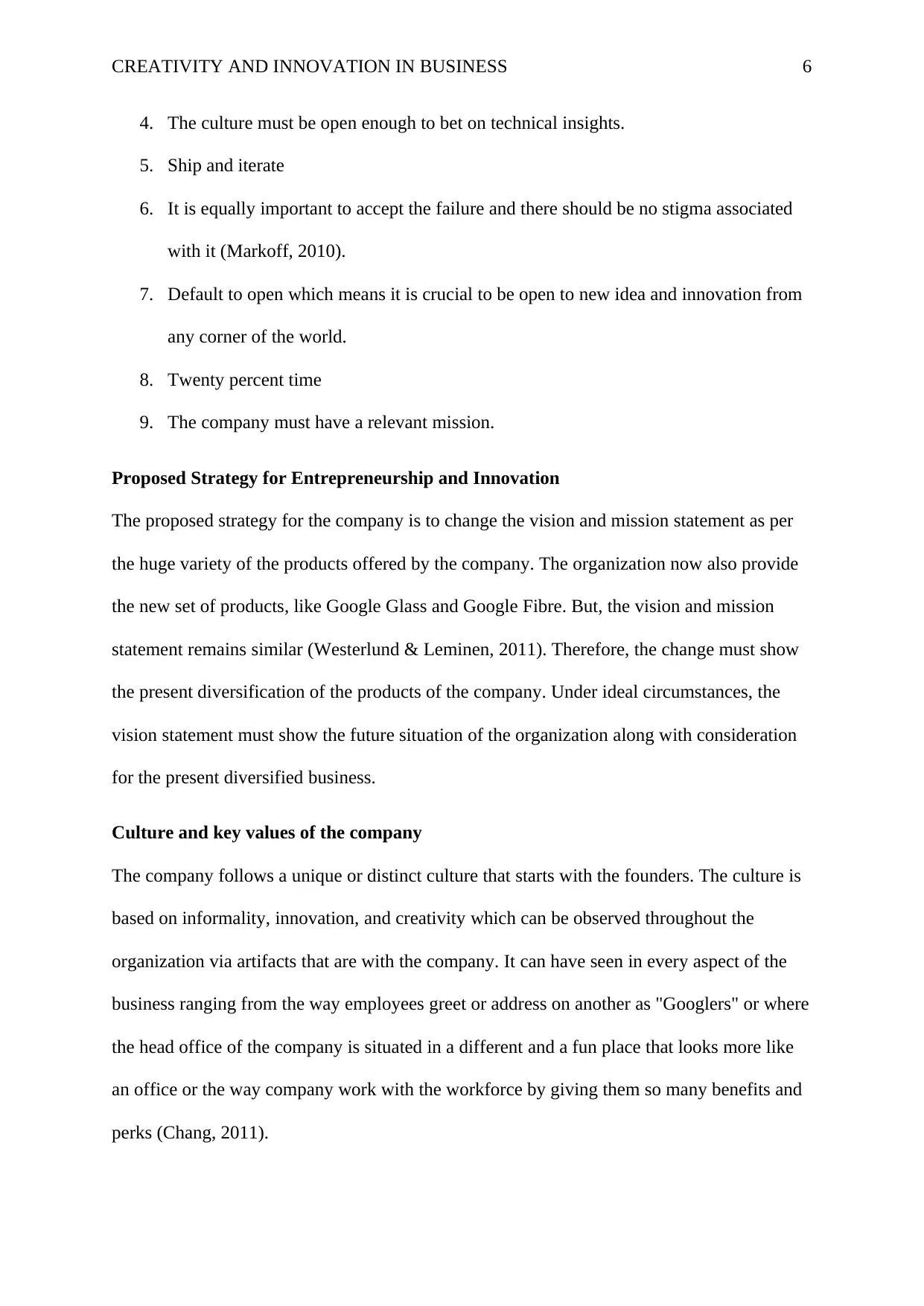
CREATIVITY AND INNOVATION IN BUSINESS 6
4. The culture must be open enough to bet on technical insights.
5. Ship and iterate
6. It is equally important to accept the failure and there should be no stigma associated
with it (Markoff, 2010).
7. Default to open which means it is crucial to be open to new idea and innovation from
any corner of the world.
8. Twenty percent time
9. The company must have a relevant mission.
Proposed Strategy for Entrepreneurship and Innovation
The proposed strategy for the company is to change the vision and mission statement as per
the huge variety of the products offered by the company. The organization now also provide
the new set of products, like Google Glass and Google Fibre. But, the vision and mission
statement remains similar (Westerlund & Leminen, 2011). Therefore, the change must show
the present diversification of the products of the company. Under ideal circumstances, the
vision statement must show the future situation of the organization along with consideration
for the present diversified business.
Culture and key values of the company
The company follows a unique or distinct culture that starts with the founders. The culture is
based on informality, innovation, and creativity which can be observed throughout the
organization via artifacts that are with the company. It can have seen in every aspect of the
business ranging from the way employees greet or address on another as "Googlers" or where
the head office of the company is situated in a different and a fun place that looks more like
an office or the way company work with the workforce by giving them so many benefits and
perks (Chang, 2011).
4. The culture must be open enough to bet on technical insights.
5. Ship and iterate
6. It is equally important to accept the failure and there should be no stigma associated
with it (Markoff, 2010).
7. Default to open which means it is crucial to be open to new idea and innovation from
any corner of the world.
8. Twenty percent time
9. The company must have a relevant mission.
Proposed Strategy for Entrepreneurship and Innovation
The proposed strategy for the company is to change the vision and mission statement as per
the huge variety of the products offered by the company. The organization now also provide
the new set of products, like Google Glass and Google Fibre. But, the vision and mission
statement remains similar (Westerlund & Leminen, 2011). Therefore, the change must show
the present diversification of the products of the company. Under ideal circumstances, the
vision statement must show the future situation of the organization along with consideration
for the present diversified business.
Culture and key values of the company
The company follows a unique or distinct culture that starts with the founders. The culture is
based on informality, innovation, and creativity which can be observed throughout the
organization via artifacts that are with the company. It can have seen in every aspect of the
business ranging from the way employees greet or address on another as "Googlers" or where
the head office of the company is situated in a different and a fun place that looks more like
an office or the way company work with the workforce by giving them so many benefits and
perks (Chang, 2011).
⊘ This is a preview!⊘
Do you want full access?
Subscribe today to unlock all pages.

Trusted by 1+ million students worldwide
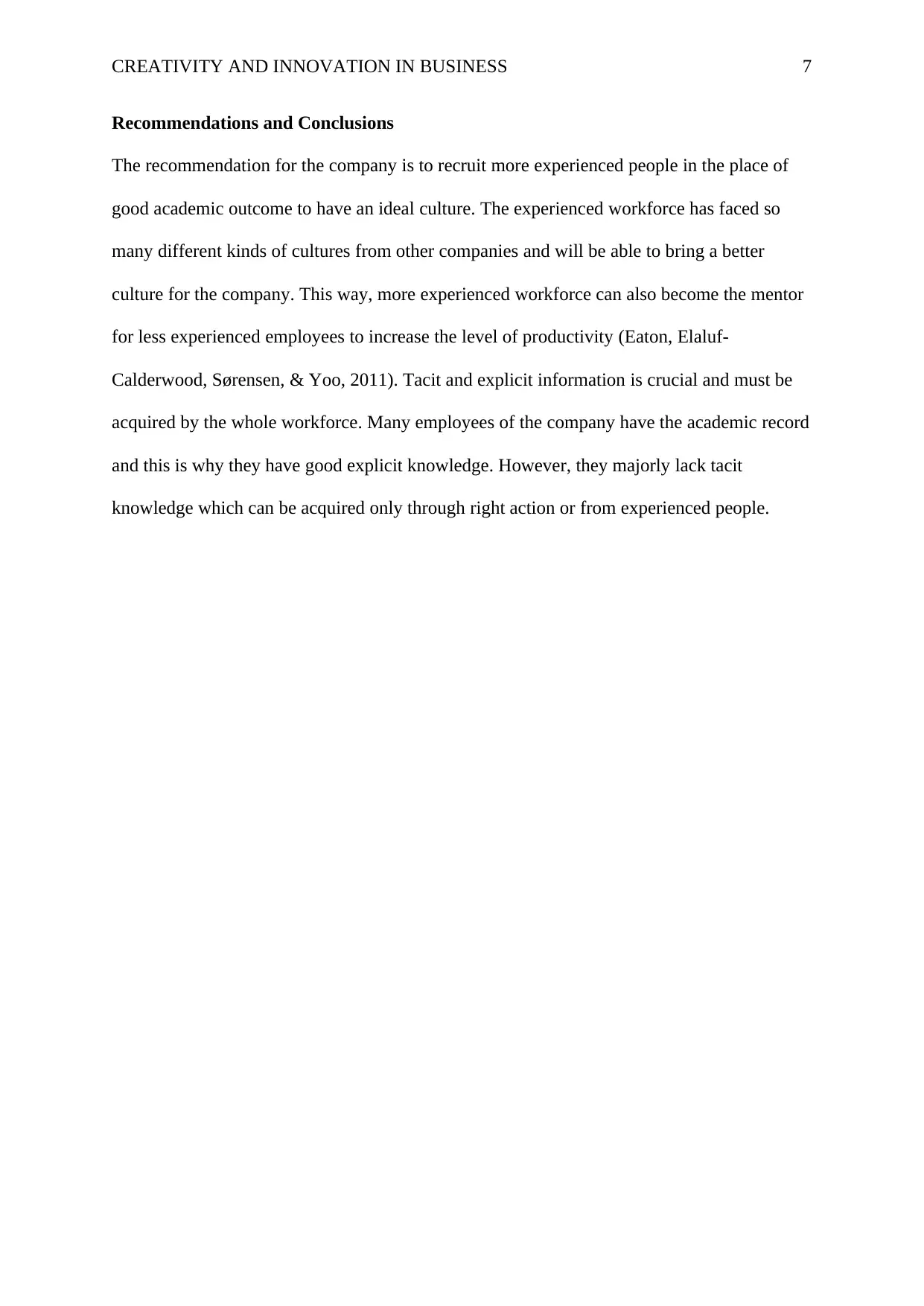
CREATIVITY AND INNOVATION IN BUSINESS 7
Recommendations and Conclusions
The recommendation for the company is to recruit more experienced people in the place of
good academic outcome to have an ideal culture. The experienced workforce has faced so
many different kinds of cultures from other companies and will be able to bring a better
culture for the company. This way, more experienced workforce can also become the mentor
for less experienced employees to increase the level of productivity (Eaton, Elaluf-
Calderwood, Sørensen, & Yoo, 2011). Tacit and explicit information is crucial and must be
acquired by the whole workforce. Many employees of the company have the academic record
and this is why they have good explicit knowledge. However, they majorly lack tacit
knowledge which can be acquired only through right action or from experienced people.
Recommendations and Conclusions
The recommendation for the company is to recruit more experienced people in the place of
good academic outcome to have an ideal culture. The experienced workforce has faced so
many different kinds of cultures from other companies and will be able to bring a better
culture for the company. This way, more experienced workforce can also become the mentor
for less experienced employees to increase the level of productivity (Eaton, Elaluf-
Calderwood, Sørensen, & Yoo, 2011). Tacit and explicit information is crucial and must be
acquired by the whole workforce. Many employees of the company have the academic record
and this is why they have good explicit knowledge. However, they majorly lack tacit
knowledge which can be acquired only through right action or from experienced people.
Paraphrase This Document
Need a fresh take? Get an instant paraphrase of this document with our AI Paraphraser
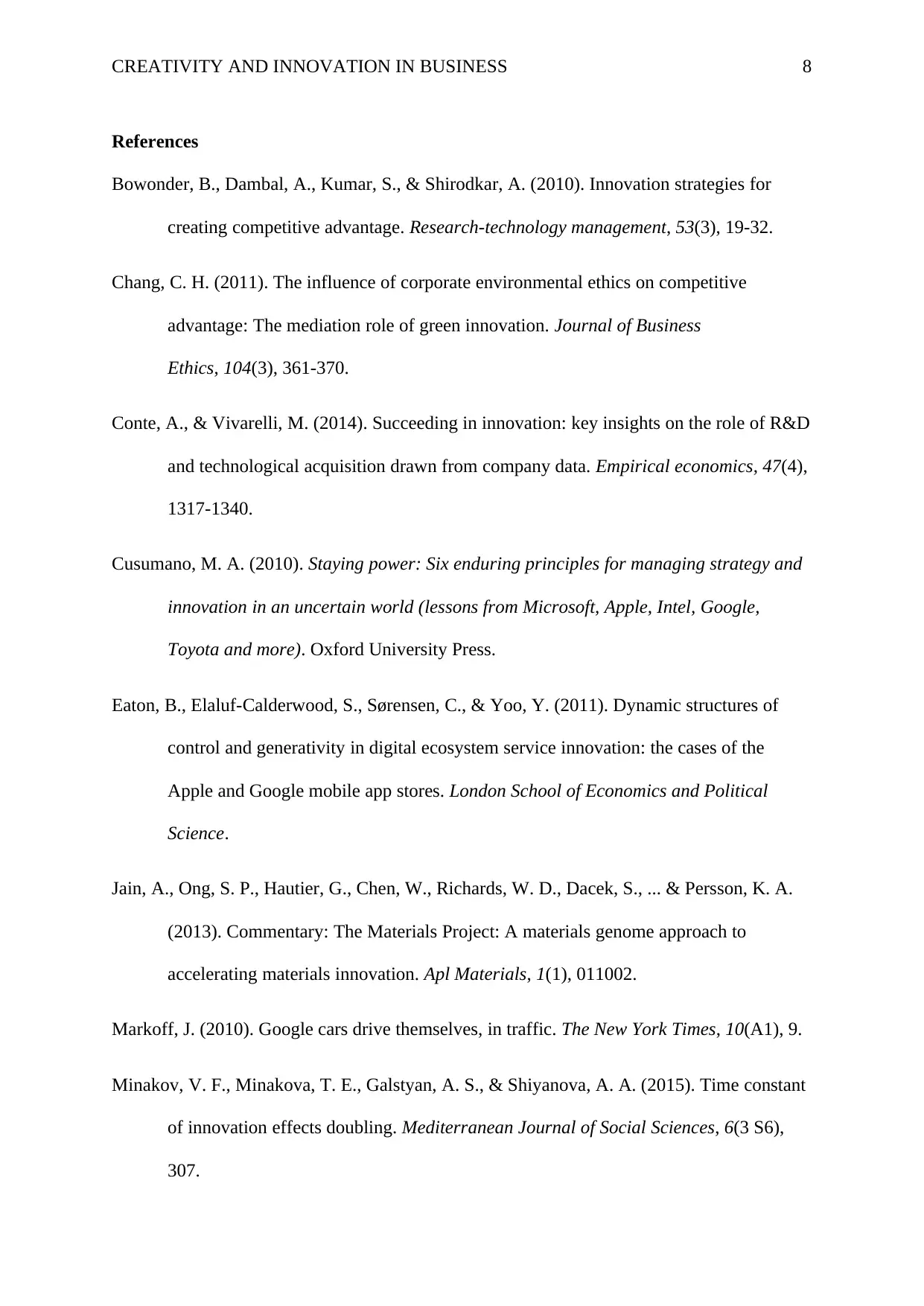
CREATIVITY AND INNOVATION IN BUSINESS 8
References
Bowonder, B., Dambal, A., Kumar, S., & Shirodkar, A. (2010). Innovation strategies for
creating competitive advantage. Research-technology management, 53(3), 19-32.
Chang, C. H. (2011). The influence of corporate environmental ethics on competitive
advantage: The mediation role of green innovation. Journal of Business
Ethics, 104(3), 361-370.
Conte, A., & Vivarelli, M. (2014). Succeeding in innovation: key insights on the role of R&D
and technological acquisition drawn from company data. Empirical economics, 47(4),
1317-1340.
Cusumano, M. A. (2010). Staying power: Six enduring principles for managing strategy and
innovation in an uncertain world (lessons from Microsoft, Apple, Intel, Google,
Toyota and more). Oxford University Press.
Eaton, B., Elaluf-Calderwood, S., Sørensen, C., & Yoo, Y. (2011). Dynamic structures of
control and generativity in digital ecosystem service innovation: the cases of the
Apple and Google mobile app stores. London School of Economics and Political
Science.
Jain, A., Ong, S. P., Hautier, G., Chen, W., Richards, W. D., Dacek, S., ... & Persson, K. A.
(2013). Commentary: The Materials Project: A materials genome approach to
accelerating materials innovation. Apl Materials, 1(1), 011002.
Markoff, J. (2010). Google cars drive themselves, in traffic. The New York Times, 10(A1), 9.
Minakov, V. F., Minakova, T. E., Galstyan, A. S., & Shiyanova, A. A. (2015). Time constant
of innovation effects doubling. Mediterranean Journal of Social Sciences, 6(3 S6),
307.
References
Bowonder, B., Dambal, A., Kumar, S., & Shirodkar, A. (2010). Innovation strategies for
creating competitive advantage. Research-technology management, 53(3), 19-32.
Chang, C. H. (2011). The influence of corporate environmental ethics on competitive
advantage: The mediation role of green innovation. Journal of Business
Ethics, 104(3), 361-370.
Conte, A., & Vivarelli, M. (2014). Succeeding in innovation: key insights on the role of R&D
and technological acquisition drawn from company data. Empirical economics, 47(4),
1317-1340.
Cusumano, M. A. (2010). Staying power: Six enduring principles for managing strategy and
innovation in an uncertain world (lessons from Microsoft, Apple, Intel, Google,
Toyota and more). Oxford University Press.
Eaton, B., Elaluf-Calderwood, S., Sørensen, C., & Yoo, Y. (2011). Dynamic structures of
control and generativity in digital ecosystem service innovation: the cases of the
Apple and Google mobile app stores. London School of Economics and Political
Science.
Jain, A., Ong, S. P., Hautier, G., Chen, W., Richards, W. D., Dacek, S., ... & Persson, K. A.
(2013). Commentary: The Materials Project: A materials genome approach to
accelerating materials innovation. Apl Materials, 1(1), 011002.
Markoff, J. (2010). Google cars drive themselves, in traffic. The New York Times, 10(A1), 9.
Minakov, V. F., Minakova, T. E., Galstyan, A. S., & Shiyanova, A. A. (2015). Time constant
of innovation effects doubling. Mediterranean Journal of Social Sciences, 6(3 S6),
307.
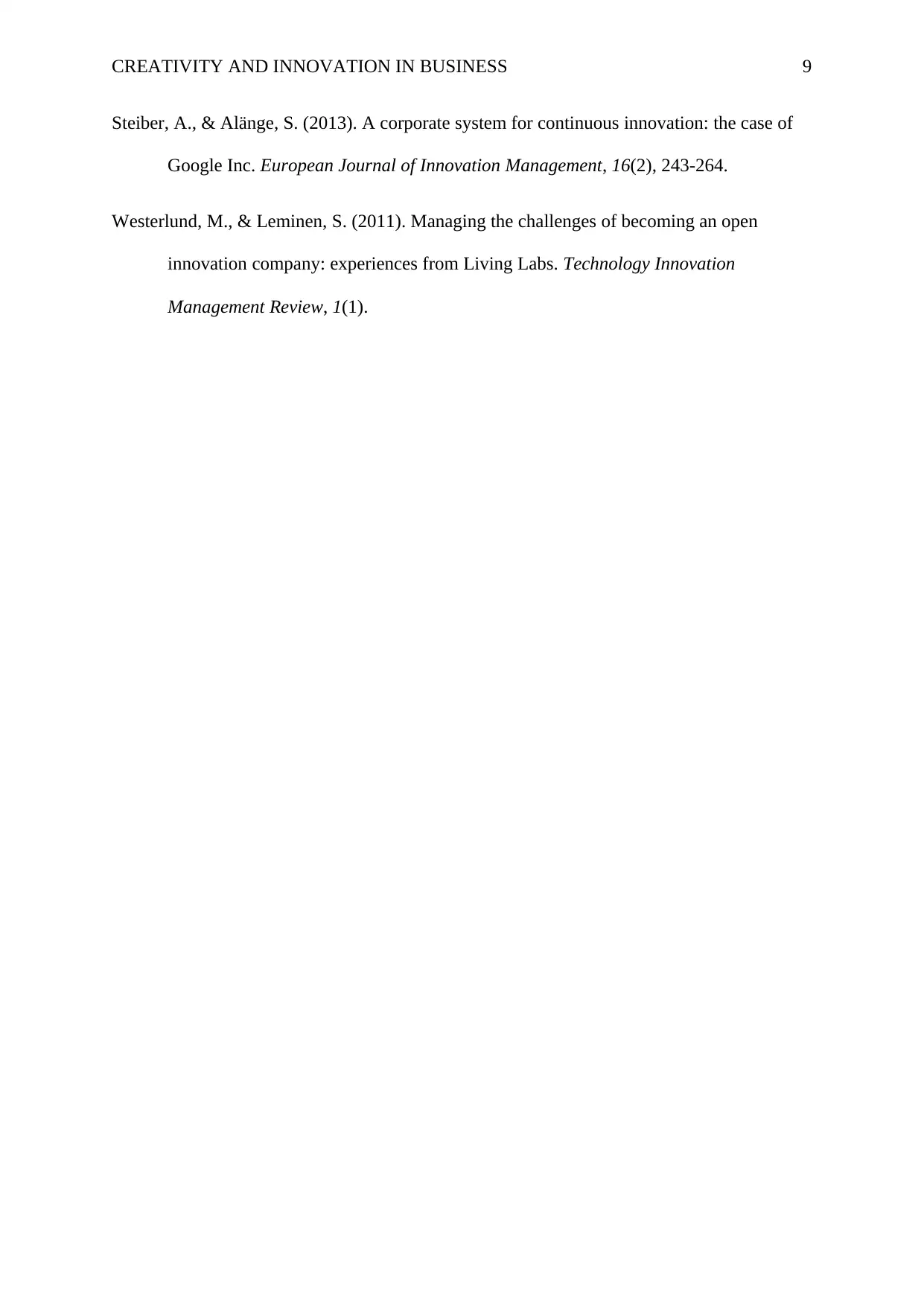
CREATIVITY AND INNOVATION IN BUSINESS 9
Steiber, A., & Alänge, S. (2013). A corporate system for continuous innovation: the case of
Google Inc. European Journal of Innovation Management, 16(2), 243-264.
Westerlund, M., & Leminen, S. (2011). Managing the challenges of becoming an open
innovation company: experiences from Living Labs. Technology Innovation
Management Review, 1(1).
Steiber, A., & Alänge, S. (2013). A corporate system for continuous innovation: the case of
Google Inc. European Journal of Innovation Management, 16(2), 243-264.
Westerlund, M., & Leminen, S. (2011). Managing the challenges of becoming an open
innovation company: experiences from Living Labs. Technology Innovation
Management Review, 1(1).
⊘ This is a preview!⊘
Do you want full access?
Subscribe today to unlock all pages.

Trusted by 1+ million students worldwide
1 out of 9
Related Documents
Your All-in-One AI-Powered Toolkit for Academic Success.
+13062052269
info@desklib.com
Available 24*7 on WhatsApp / Email
![[object Object]](/_next/static/media/star-bottom.7253800d.svg)
Unlock your academic potential
Copyright © 2020–2025 A2Z Services. All Rights Reserved. Developed and managed by ZUCOL.





